“Cooking is great. Outdoors is even better!” This quote by tour guide and mountaineer Ricardo Oliveira sums up the experience of the first class of the Cozinha Outdoor course, part of the Gear Tips Empowerment Program, held in March 2025.
The course aims to highlight to nature lovers and outdoor professionals that eating well and nutritiously during outdoor adventures is important—and doesn’t have to be complicated. Over two days of camping, participants had access to equipment, menu planning, creative recipes, and techniques for preparing meals, as well as learning how to minimize environmental impact. The immersion took place in Alto da Boa Vista (in the city of Rio de Janeiro), at a space run by Agrega Alto, a community-based tourism project.
Moaci Judson, who has been cooking since his scout days and has always enjoyed experimenting with new possibilities, led the course and shared his extensive experience. “At age 11, I was my patrol’s cook. We prepared meals over campfires and then graduated to a two-burner stove. My grandmother taught me to cook a few things like beans, rice, and sausage. Years later, I started to study, get informed, and test new recipes and techniques,” says Moaci, who has worked as an instructor since 2012.
Under his guidance, the group got hands-on and learned to use various ingredients—many of them previously unknown to participants—to prepare a robust menu that included stroganoff (including a vegan version); tapioca, corn, Moroccan, and São Paulo-style couscous; as well as lasagna, pizza, stuffed bread, cheese bread, and even chocolate cake!
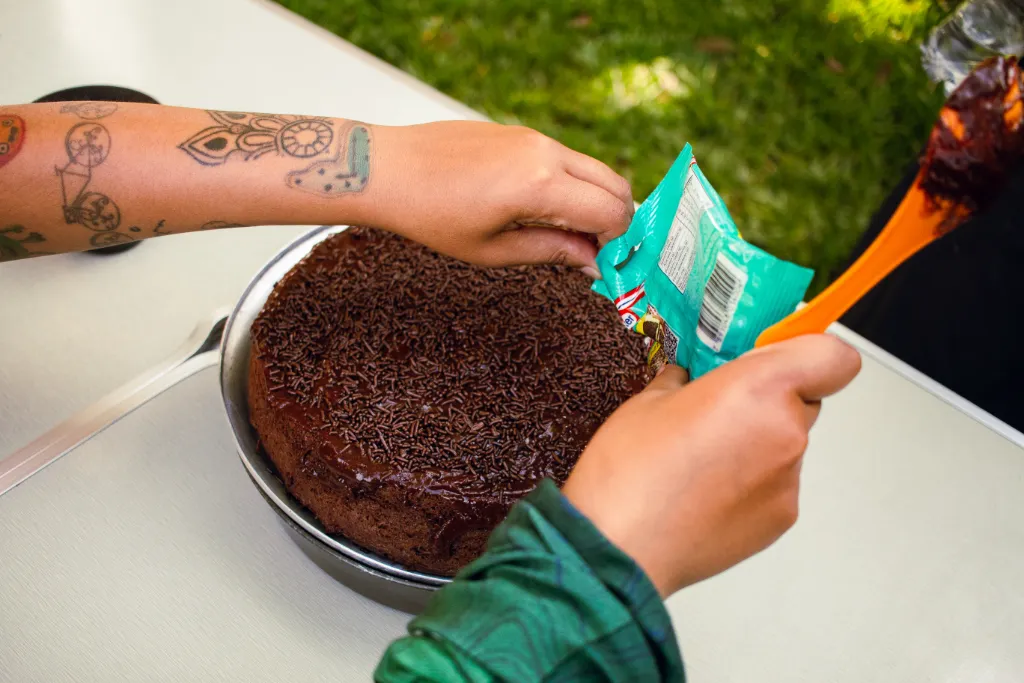
Photo: Taísa Maar
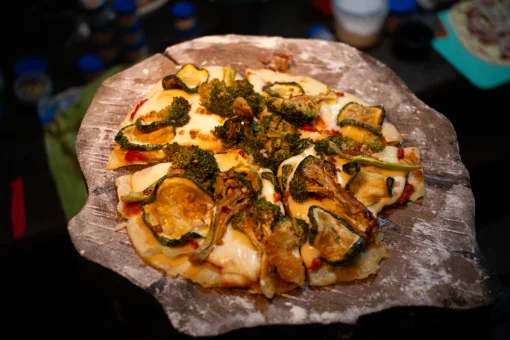
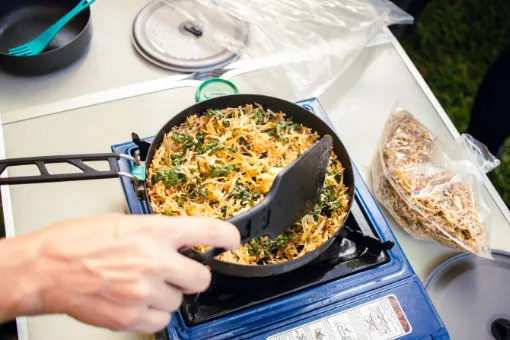
Photos: Taísa Maar
Ricardo, who usually brings easy-to-carry items on his expeditions—like freeze-dried foods, canned tuna, and cream—said his perspective changed after the course. “I had the chance to discover low-cost, easy-to-carry options to make tasty and nutritious meals. I was amazed by the variety of dehydrated foods and learned to use powdered versions of tomato sauce and eggs,” says Ricardo, who helped prepare the classic stroganoff, the pizza, and the scrambled eggs for breakfast.
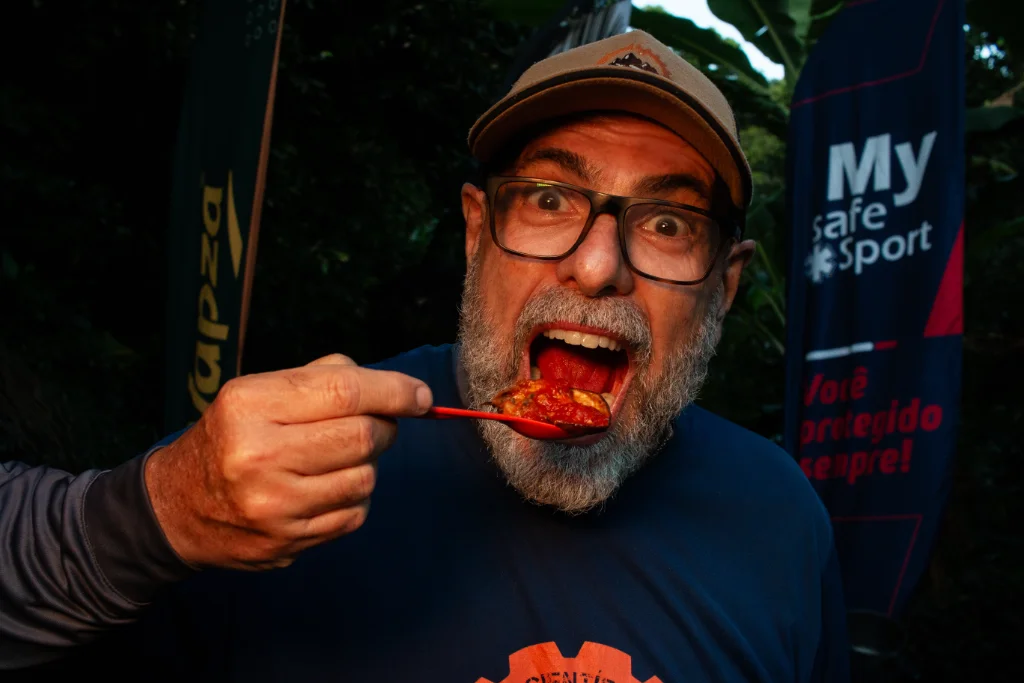
Ricardo during the course. Photo: Taísa Maar
Moaci explains that, in addition to lightening the backpack, dehydrated foods—such as zucchini and eggplant—are easier to preserve during expeditions. “Besides that, they expand your options and add much more flavor to your meals. Powdered products like tomato sauce are still not very well known. I’m always researching to discover new possibilities.”
For Kelson Tavares, an experiential tourism guide, the course was also inspiring. “On expeditions, I used to bring canned foods, which creates a huge amount of waste to carry back. I found the options presented in the course quite innovative, such as the PROMEAL feijoada meal kit that already comes with rice. The packaging is easier to carry, and the food is much tastier. I also didn’t know about powdered tomato sauce. I’m now motivated to look for more solutions like these.”
The key lesson Kelson took from the Cozinha Outdoor course was that it is possible to eat well even in remote areas, in mountains, and on trails. “You don’t have to settle for limited meals—and you don’t have to suffer eating instant noodles! In the course, I made pizza with the group and tasted the very popular stroganoff, as well as the bread, which was delicious.”
Danielle Hepner, who has been practicing outdoor activities since 2015, shared that at the beginning of her journey in nature, she relied on simple solutions like instant noodles. Over time, she realized the importance of good nutrition to perform well during expeditions. She started bringing some food from home, but never imagined she could make lasagna outdoors—an experience she considers transformative.
“My recipes used to be very limited. I never imagined I’d make lasagna outdoors! I thought it would be a disaster, but I was surprised. We used dehydrated zucchini and eggplant in the dough, dehydrated sauce, spices, and lots of cheese on top. An unforgettable dish! I can’t wait to prepare it in the wild!”
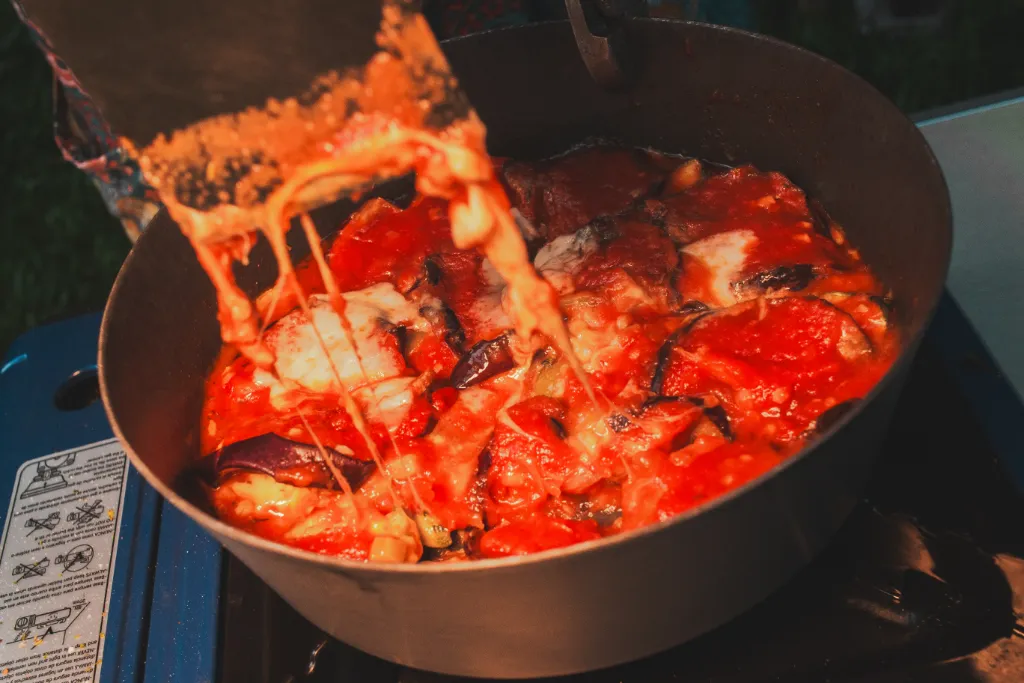
Lasagna, one of the recipes from the Cozinha Outdoor course. Photo: Taísa Maar
For Monica Morais, who made a chocolate cake that was praised by everyone, the course brought together four amazing experiences: camping, cooking, learning, and community. One of the highlights for her was the dynamic methodology that got everyone involved hands-on.
“The course made me think about adding the culinary experience to an expedition. It becomes an activity in itself, beyond trekking. I believe that a good meal brings people together, offers great comfort, and provides the nutrients needed to enjoy outdoor activities even more. We made rosti-style potatoes, which I loved, as well as an amazing bread and a vegetarian stroganoff. I felt like I was on MasterChef!”
Moaci says the course adds great value both to the experiences offered by tour guides and to the adventures of nature lovers traveling with friends. “The experiences become more complete and enjoyable. Plus, we break the stereotypes of outdoor meals, teaching people to make better use of available resources and move beyond the same old options—always prioritizing nutrition. We introduced a whole universe of outdoor cooking, from practical, affordable recipes to more elaborate dishes.”
Gear and techniques sparked participants’ curiosity
Another aspect that caught the students’ attention during the Cozinha Outdoor course was the variety of gear and techniques introduced. “During the course, we explored different types of fuel—gas, alcohol, pressurized liquid fuel, solid fuel, and biomass—and their respective stoves, highlighting the advantages and limitations of each system,” explains Pedro Lacaz Amaral, Gear Tips partner and instructor of the course alongside Moaci Judson.
In addition, participants got to know a wide range of kitchen utensils, from ultralight and compact models for solo treks to more robust options for structured camping. “We demonstrated and used everything from an ultralight pot to a dutch oven—a cast iron pot,” says Pedro.
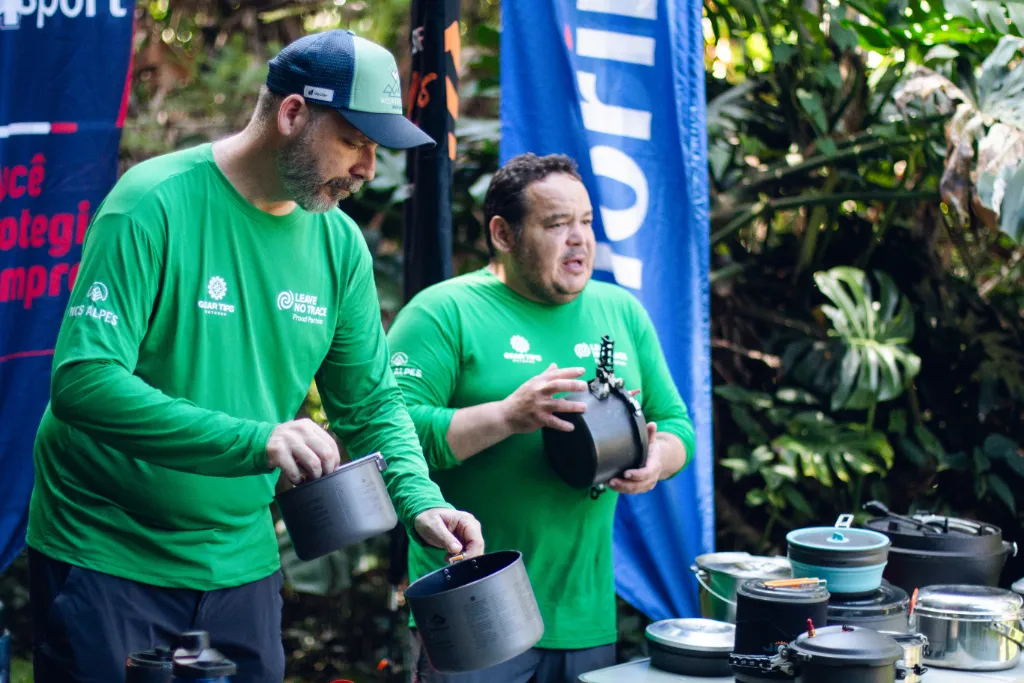
Pedro and Moaci, instructors of the Gear Tips Cozinha Outdoor Course. Photo: Taísa Maar
For Ricardo, the knowledge shared by the instructors was enriching. “The course introduced gear I didn’t even know existed. I was surprised by the number of utensils, stoves, types of fuel, and the possibility of using natural resources like twigs and dry leaves.”
Kelson and Danielle said they were amazed by the Kelly Kettle, presented by Pedro, which allows you to boil water and cook quickly outdoors. “The equipment is truly impressive! It’s really easy to handle and even comes with a little stove on top, along with other accessories,” said Kelson.

Kelson using the Kelly Kettle. Photo: Taísa Maar
For Danielle, the gear added a lot to the course experience. “Besides a special pot for baking bread, I was impressed by the features of the Kelly Kettle. You can fuel it with twigs instead of gas to create a mini campfire inside the device in a safe way. I thought it was awesome that the course introduced this kind of innovative equipment. Everyone was fascinated!”
The Cozinha Outdoor course also gave Danielle her first experience turning a camp stove into a type of oven, using foil to bake lasagna. For Monica, the novelty was using a stove with white gas, something she had only done with traditional gas before.
“By experiencing the practical use of this gear in different contexts, students understood how compatibility between components—and alignment with the activity type—directly affects safety, efficiency, and comfort on the trail. After all, a solid cooking system goes beyond picking standalone items; it must meet the expedition’s actual needs and function as a cohesive unit,” explains Pedro.
With planning, everyone eats well
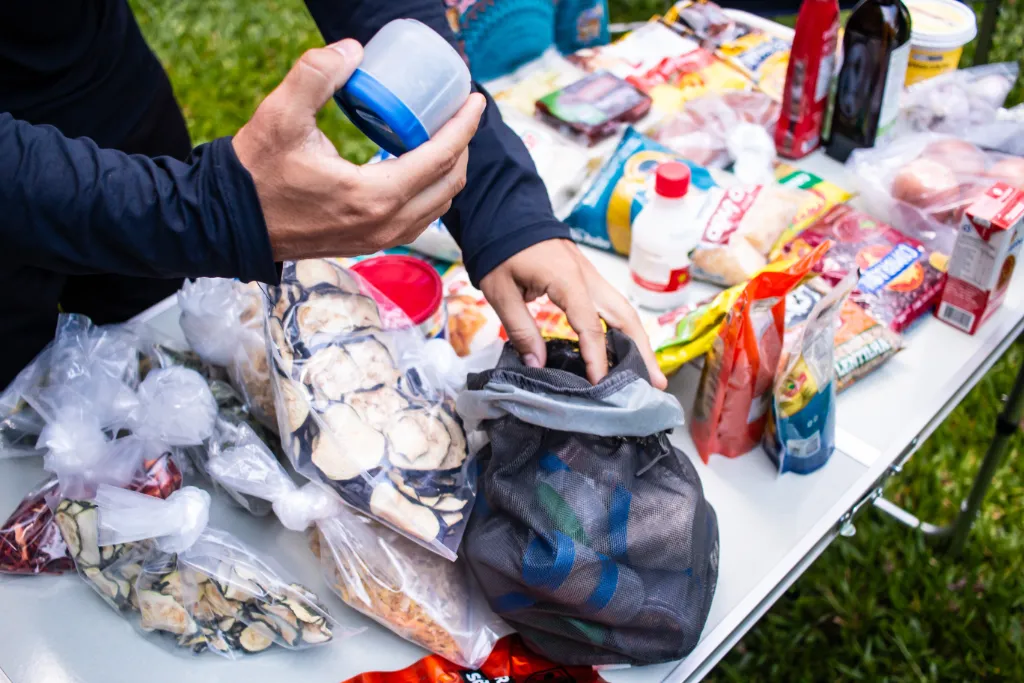
Camping menu planning. Photo: Taísa Maar
During the Cozinha Outdoor course, students learned the importance of properly planning and assembling a kitchen system—thinking of the equipment as interdependent parts that need to function in an integrated and safe manner.
“Even before choosing the gear, it’s essential to define the context of the activity, depending on the biome, season, and expected temperatures, as well as assessing the availability of water and fuel. It’s also important to define whether meals will be prepared individually, as a pair, or in a group, and what kind of food the person intends to make,” explains Pedro.
Having these answers helps structure the ideal setup for each expedition by consciously selecting four key elements:
- Heat source (stove or alternative)
- Cooking gear (pots, kettles, pans – the cookware)
- Eating gear (plates, bowls, mugs, cutlery – the dinnerware)
- Ignition method (lighters, matches, fire starters, etc.)
The course also taught participants how to plan food quantity and organization. “Learning about new gear and types of food to bring on expeditions and other activities was essential for planning—which is the foundation of everything,” says Ricardo.
Monica always saw food as essential to providing both pleasure and nutrition during outdoor adventures, but admits she often overpacked. “My backpacks were heavy because of the amount of food—it was a pain to carry. We brought too much and didn’t eat it all.”
Another key lesson for anyone cooking in natural environments is understanding how to minimize environmental impact. The course also covers some of the principles of Leave No Trace. “We learned how to cook while leaving less impact on nature. It was great,” adds Kelson.
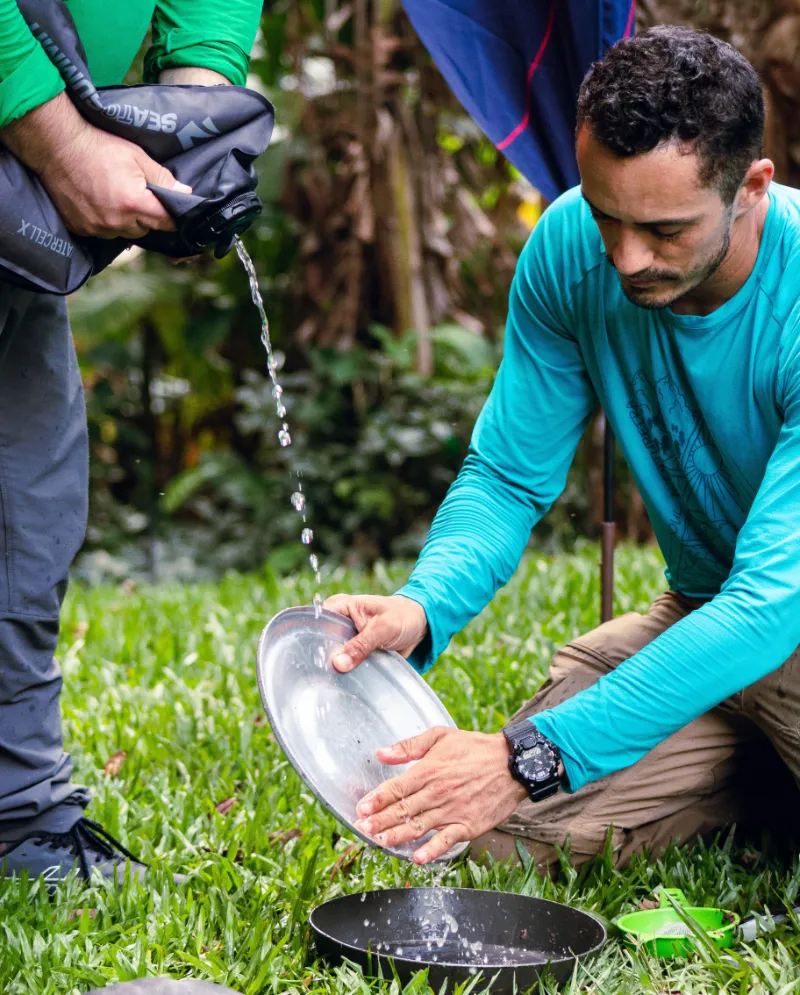
Cleaning cooking utensils following low-impact principles. Photo: Taísa Maar
This post is also available in: Português (Portuguese (Brazil)) Español (Spanish)
